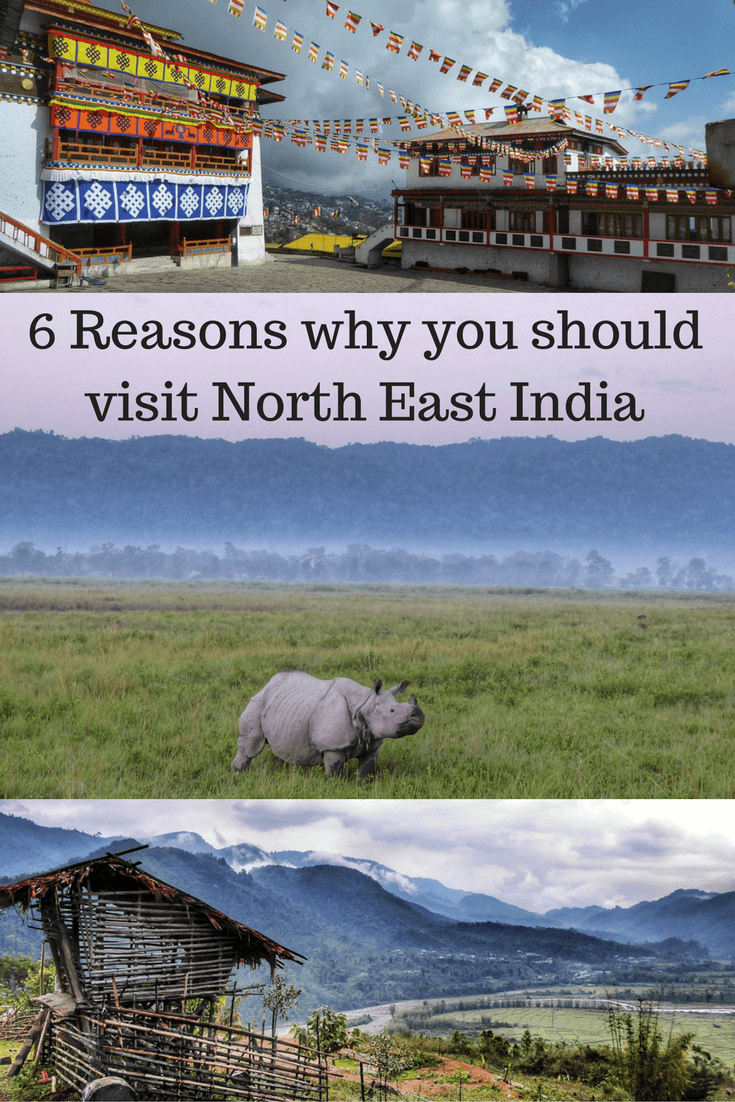Visit North East India
North East India is tucked away in between Bangladesh, Tibet, Bhutan and
Myanmar and is a world away from the chaos of
Delhi and other tourist clichés you might expect when you think of India. These diverse and beautiful, remote tribal lands are only just opening up to tourism and are home to some of the most intriguing tribal people, rare wildlife and stunning scenery in India.

Why You Should Visit North East India
The North East is still a relatively unexplored paradise for intrepid travellers but popularity is growing and the region is quickly becoming
India’s hottest new destination so to if you want to witness this region so blissfully untouched by tourism (so far) then you’ll have to visit soon!
Here’s why you should visit North East India
Meet tribal people and learn about their unique way of life
Remote North East India has been cut off from the rest of the world for ages and so it’s one of the rare places in the world where you can meet authentic tribal people who live a very different way of life even in this modern age. North East India is one of the most culturally diverse areas of the world and is home to over 200 tribes including unique, fascinating tribes like the opium smoking, head hunter tribes in Nagaland and the facially tattooed, sun and moon worshipping Apatani tribe in Ziro Valley,
Arunachal Pradesh.

Meet tribal people
One of the best ways to experience the vibrant and unique cultures of North East India’s intriguing tribal people is through one of the many amazing tribal festivals. Witnessing the riot of colour, music and dance and even some sacrifices and unique rituals of a traditional tribal festival in North East India is sure to be an unforgettable experience.

Headhunter Man
Don’t worry, they don’t practise head hunting anymore and it’s a fascinating experience to meet the tribal people and find out about their way of life but it’s best to take a tour with a local guide if you want to be made to feel welcome and to really understand about their way of life.
See rare and endangered wildlife
Because the region is so unspoilt and unexplored North East India is a refuge to many rare and endangered animals and there are many fantastic UNESCO listed national parks where animal lovers can
take safaris and witness exotic animals in their natural habitat. One of the most famous is Kaziranga National Park in Assam where close up sightings of engaged one horned rhinos are pretty much guaranteed (even the Duke and Duchess of Cambridge visited here on their India tour) Manas Wildife Sanctuary, also in Assam, is home to more endangered species than any other sanctuary in India or visit Nokrek National Park in Meghalaya to look out for red pandas, tigers, elephants, rare breeds of macaques and marbled cats.
Experience the beautiful, colourful Tibetan culture (without visiting Tibet)

The Colourful Tibetan Culture
North East India is nestled up against the border of Tibet and parts of the mountainous state of Arunachal Pradesh actually used to be part of Tibet. Visit the remote Tawang region where colourful Tibetan prayer flags flutter over the peaceful valleys and you can experience the enchanting, serene and colourful Tibetan culture and religion carrying on peacefully in the historic monasteries, prayer wheels and stupas and enjoy delicious and authentic Tibetan food like momos and thukpas.

Immerse in Tibetan Culture
Explore unspoilt nature and stunning scenery

Waterfalls and beautiful scenery
North East India is home to some of the most stunning, diverse and unspoilt scenery in India; from the snow capped peaks of the soaring Himalayan mountains, to the grassy plains of Assam and the steamy forests and majestic waterfalls of Meghalaya – North East India showcases unspoilt nature at its finest!
Experience a totally different and hassle free side to India

Unspoiled North East India
If the horror stories of dirt, hassle and chaos put you off visiting India at all then exploring North East India offers you the chance to experience a totally different side to India. This region is just so different that sometimes I could hardly believe I was still in India – the scenery, the food, the people, the culture everything is different.

Beautiful India
Even though a lack of infrastructure makes traveling here a little bumpy and slow moving at times, I found North East India a welcome escape from the chaos and hassle that you get in the more touristy parts of India, no one tried to cheat me or touch me or even sell me anything and the people of North East India where some of the friendliest and most genuine people I’ve ever met on my travel.
Get off the beaten track: North East India is still unexplored, authentic and blissfully untouristy

Getting off the Beaten Path
In fact some parts of the mountains in Arunachal Pradesh have not even been mapped! Yes, this means that traveling here can be a bit bumpy and there’s no luxury hotels but if an adventure is what you’re after than North East India is the place to come!

Not your average travel experience
There aren’t many places in the world with blank spaces on the map, where people have hardly any idea that the modern world exists, where creatures have yet to be named and mountains yet to be climbed but North East India is still totally off the beaten track. It’s an amazing feeling to go somewhere hardly anyone else has gone but you’ll need to go now before everyone else does!
Tips for visiting North East India
North East India consists of 7 sister states – Assam, Meghalaya, Nagaland, Arunachal Pradesh, Manipur, Mizoram and Tripura which all have different cultures, tribes, languages, food and scenery that are just heaven for intrepid explorers!

























